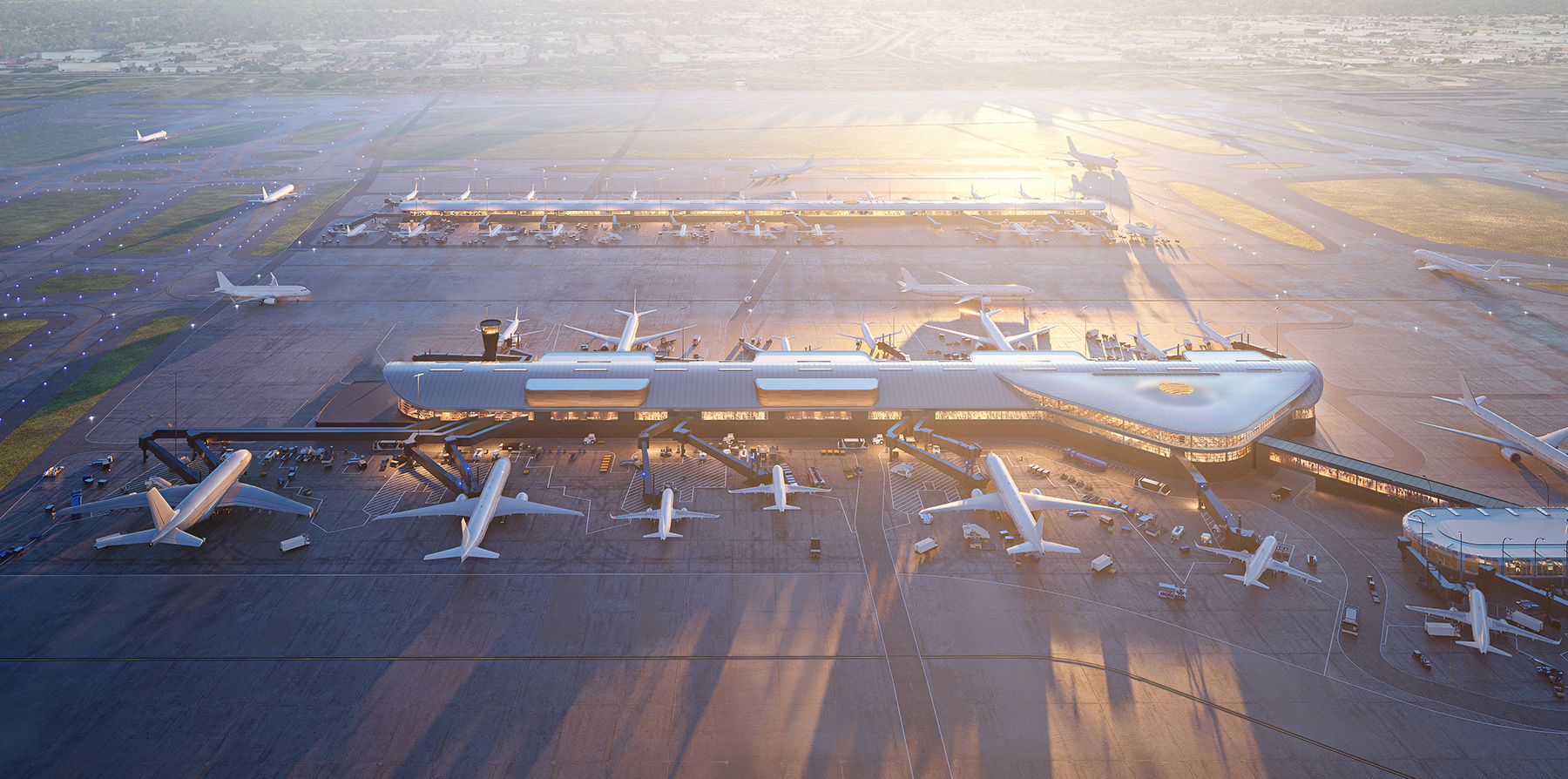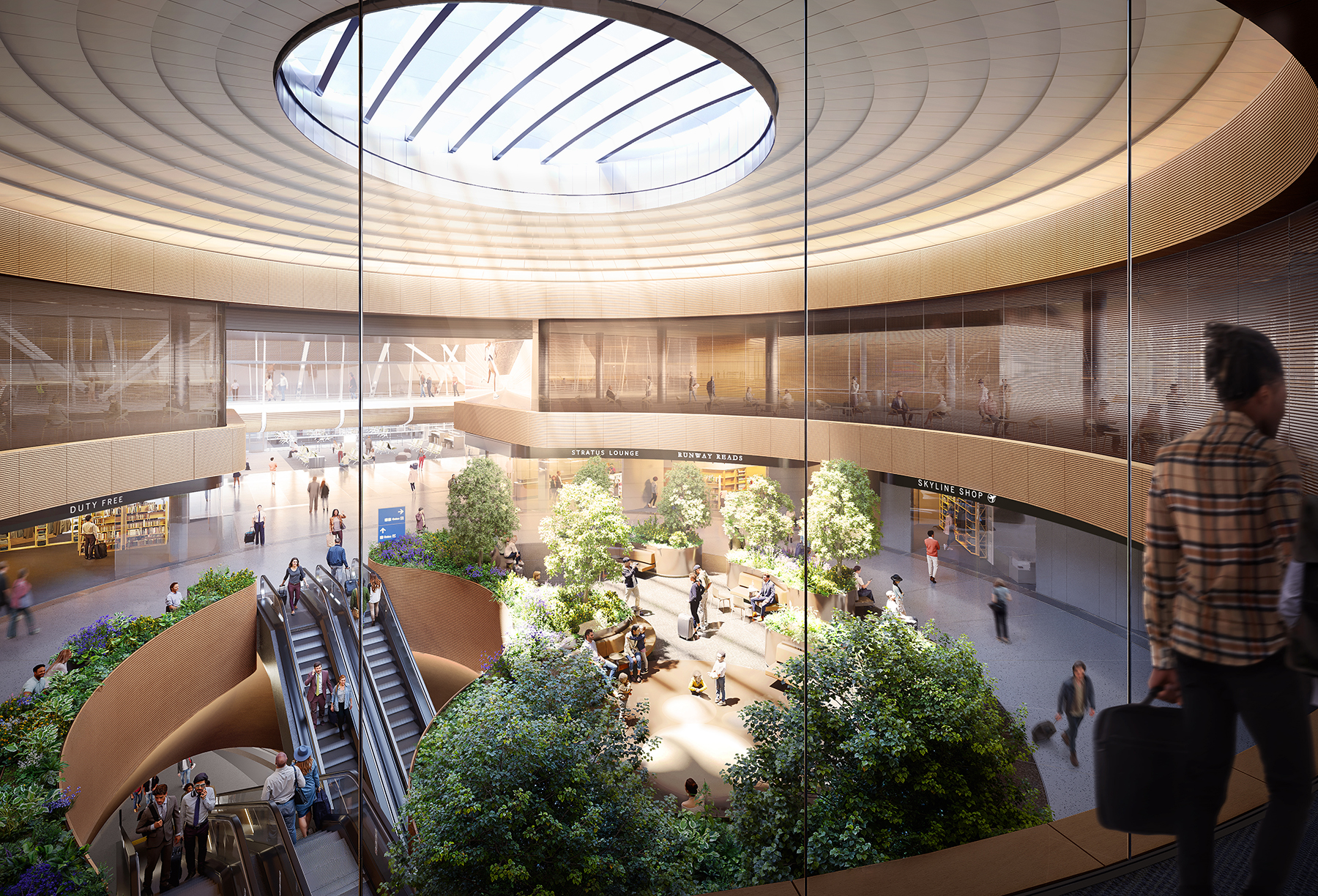 Rendering courtesy of city of Chicago
Rendering courtesy of city of ChicagoConcourse D, the largest expansion in the history of Chicago’s O’Hare International Airport, broke ground in August, paving the way for 19 new aircraft gates to help meet the growing demand of traffic through the airport, which exceeded 80 million passengers last year.
Designed by Skidmore, Owings & Merrill, in collaboration with Ross Barney Architects, Juan Gabriel Moreno Architects, and Arup, the $1.3 billion project responds to calls for sustainable construction and operation.
Further reading:
- Innovative approach helps Atlanta airport grow with the times
- Oregon gains power-efficient, seismically robust airport terminal
- New LA airport terminal celebrates construction, engineering ‘firsts’
“From passenger flow to the structure and enclosure, the biggest challenge was efficiency – in terms of material, space, and embodied carbon,” said SOM design partner Scott Duncan, AIA, LEED AP. “At every stage of design, we looked for opportunities to do more with less: reducing the amount of steel, glazing, and other materials while optimizing the interior footprint and volume.”
A 40-foot-high atriumlike space, complete with a central oculus beaming daylight down through three levels below, will punctuate the northern end of the 590,000-square-foot building. From there, a curled roof supported by a series of tree columns will extend to cover the remaining gate areas of the new concourse, which the team estimates it will complete in 2028.
 Rendering courtesy of city of Chicago
Rendering courtesy of city of Chicago
“Our inspiration came from the site’s history as an orchard,” said Duncan, recalling O’Hare’s original name of Orchard Field, from which the airport continues to bear the code of ORD. “We designed Concourse D to reflect that legacy, with a structural system that takes the form of an orchard. Treelike columns branch out to support a light-filtering roof, with the dappled daylight of a tree canopy. The daylight and expansive open spaces enabled by the columns create a sense of calm and wellness for passengers, while delivering a more efficient, sustainable terminal.”
Both the shape of the roof and the tree-column design help save material and energy.
The curved-roof profile reduces the overall building volume by about 21% compared with a traditional box profile, lowering the air-conditioning demand and allowing the building’s systems to react faster to changes in heating loads, says Benton Johnson, P.E., M.ASCE, a SOM structural engineering principal.
The arched design also lowers the height of the side walls, reducing the exterior surface area and glazing requirements by 17% relative to the traditional box. Along with deep overhangs, the reduced glazing further improves the building’s operational efficiency by cutting down on solar gain, while also lowering glare.
The tree columns, which branch at the roofline, reduce the need for conventional supports by more than 40%, Johnson says. The reduction opens “the concourse for improved circulation and clearer sight lines while increasing support for the roof, which reduces the overall steel tonnage.”
Johnson says the design results in about 4,500 tons of structural steel.
The columns also support a suspended sterile corridor, which connects areas beyond security checkpoints, with steel rods that double as the support for the corridor’s glazing.
“Together, the tree-column system and curved roof show how structural design can drive efficiency, not only cutting steel and glass use but also creating a more sustainable, comfortable environment for passengers,” Johnson said.
Additional sustainability elements include a roof and facade tuned to bring in controlled daylight to reduce the need for artificial lighting. Semi-mixed air systems will also focus conditioned air more on the occupied zone near the floors of high-ceiling areas for more energy savings.
Airline industry flex
The International Air Transport Association expects airline industry revenues to reach a historic high of $979 billion this year, a 1.3% increase over last year. While revenues traditionally follow global gross domestic product, the association sees airline profitability increasing despite a slowdown in global GDP growth this year, driven by falling oil prices and gains in passenger efficiency.
Passenger load factors – the ratios of paying passenger miles to available passenger miles – are expected to reach an all-time high of 84%, according to the IATA’s June financial outlook.
In support of airlines, Concourse D will offer flexibility features to improve the efficiency of airline operations. Eighteen of the concourse’s 19 narrow-body gates can be paired together to host wide-body aircraft – those wide enough to accommodate two passenger aisles onboard.
“As one of the country’s busiest layover hubs, O’Hare needs gates that can quicklyadapt – sometimes serving a single wide-body plane, other times two narrow-bodies in the same footprint,” Duncan said. “Adjustable boarding systems and integrated circulation contribute to our design that reduces congestion and turnaround times for airline operations while offering shorter waits and smoother transfers for passengers, together limiting ground time and reducing carbon emissions in the long term.”
Every gate of the new concourse will include international arrival capabilities, further expanding scheduling options for the airlines and smoothing connections for passengers, says Duncan. O’Hare’s Global Terminal will be one of the first domestic-international codeshare terminals in the country, which will open partnership possibilities between airlines to expand their routes.
 Rendering courtesy of city of Chicago
Rendering courtesy of city of Chicago
The sterile corridor, which runs along the perimeter, will also be able to serve both domestic and international operations.
“Doors open directly into the gate lounge for domestic flights and close to route passengers through customs for international arrivals, giving the airport the ability to ‘flip’ gates as needed without reconfiguring the concourse itself,” Johnson said. “Collectively, the gate sizing, structural layout, and sterile corridors provide a high level of operational flexibility for the airlines, allowing one concourse to efficiently serve both narrow- and wide-body aircrafts while meeting international regulatory requirements.”
More work to come
O’Hare’s Concourse D leads the airport’s $8.2 billion Terminal Area Plan, a vision launched in 2018 that includes a second satellite concourse, replacement of its existing Terminal 2 with the new Global Terminal, and a new underground tunnel to move people and baggage between the expanded facilities, in addition to Concourse D.
When the airport completes construction of Concourse D, the plan’s second satellite concourse, Concourse E, will be built to the west. Also designed by SOM, the additional 24 gates of the second concourse will handle domestic and international flights that do not require customs clearance, such as those from Canada and Ireland.
Beyond the Global Terminal area, O’Hare’s ORDNext initiative completed the expansion of its Terminal 5 in 2023, which added 10 new gates to the airport, and includes the rehabilitation of Terminal 3, with reconfigured passenger flows and 10,000 square feet of new commercial and amenity spaces, scheduled to complete in 2027.
 Rendering courtesy of city of Chicago
Rendering courtesy of city of Chicago


